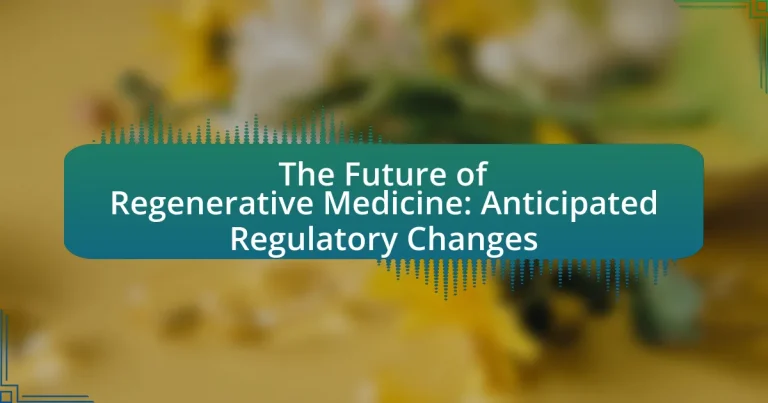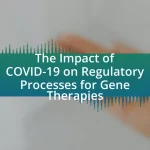The article focuses on anticipated regulatory changes in regenerative medicine, highlighting the expected implementation of streamlined approval processes for cell and gene therapies, enhanced manufacturing guidelines, and international harmonization of regulations. It discusses how these changes will impact the development of regenerative therapies by accelerating timelines and fostering innovation while ensuring patient safety. The article also addresses the challenges regulatory bodies face in adapting to rapid advancements in the field, the implications of inadequate regulation, and the role of stakeholders, including patient advocacy groups, in shaping future policies. Additionally, it outlines practical steps for researchers and companies to align with evolving regulations.

What are the anticipated regulatory changes in regenerative medicine?
Anticipated regulatory changes in regenerative medicine include the implementation of more streamlined approval processes for cell and gene therapies, as well as enhanced guidelines for manufacturing and quality control. The U.S. Food and Drug Administration (FDA) has indicated a focus on adaptive trial designs and real-world evidence to expedite the development of innovative therapies. Additionally, international harmonization of regulations is expected, as organizations like the International Society for Cell & Gene Therapy advocate for consistent standards across countries. These changes aim to facilitate patient access to advanced therapies while ensuring safety and efficacy.
How will these changes impact the development of regenerative therapies?
The anticipated regulatory changes will accelerate the development of regenerative therapies by streamlining approval processes and enhancing safety standards. These changes are designed to reduce the time and cost associated with bringing new therapies to market, which can lead to increased investment and innovation in the field. For instance, the introduction of adaptive trial designs and expedited pathways for promising therapies can significantly shorten the timeline for clinical trials, allowing for faster patient access to new treatments. Additionally, improved regulatory clarity regarding manufacturing and quality control can enhance the consistency and reliability of regenerative products, ultimately fostering greater confidence among stakeholders and patients.
What specific regulations are expected to evolve in the next decade?
Specific regulations expected to evolve in the next decade include enhanced guidelines for the approval and monitoring of regenerative medicine therapies, particularly stem cell treatments and gene therapies. Regulatory bodies like the FDA are likely to implement more stringent preclinical and clinical trial requirements to ensure safety and efficacy, as evidenced by the increasing complexity of these therapies and past incidents of unapproved treatments entering the market. Additionally, regulations surrounding the ethical sourcing of biological materials and patient consent are anticipated to become more robust, reflecting growing public concern over ethical practices in regenerative medicine.
How might these regulations affect clinical trials for regenerative medicine?
Regulations may significantly impact clinical trials for regenerative medicine by imposing stricter safety and efficacy standards. These regulations often require comprehensive preclinical data and robust clinical trial designs, which can extend the timeline and increase costs associated with bringing regenerative therapies to market. For instance, the FDA’s 21st Century Cures Act emphasizes the need for clear evidence of therapeutic benefit, which can lead to more rigorous scrutiny of trial protocols and patient recruitment strategies. Consequently, while these regulations aim to enhance patient safety and treatment effectiveness, they may also create barriers that slow down innovation and access to new regenerative therapies.
Why is regulatory change important for the future of regenerative medicine?
Regulatory change is crucial for the future of regenerative medicine because it facilitates innovation while ensuring patient safety and efficacy of treatments. As regenerative medicine evolves, new therapies, such as gene editing and stem cell applications, require updated regulations to address unique challenges and risks associated with these technologies. For instance, the U.S. Food and Drug Administration (FDA) has implemented the Regenerative Medicine Advanced Therapy (RMAT) designation to expedite the development of promising regenerative therapies, demonstrating a proactive approach to regulation that supports advancements in the field. This regulatory flexibility is essential for fostering research and development, attracting investment, and ultimately bringing effective therapies to market more efficiently.
What role do regulations play in ensuring patient safety?
Regulations play a critical role in ensuring patient safety by establishing standards and protocols that healthcare providers must follow. These regulations are designed to minimize risks associated with medical treatments and procedures, ensuring that they are safe and effective for patients. For instance, the Food and Drug Administration (FDA) in the United States enforces regulations that require rigorous testing and clinical trials for new medical products, which helps to identify potential safety issues before they reach the market. Additionally, regulations mandate ongoing monitoring of medical products post-approval, allowing for timely responses to any emerging safety concerns. This structured oversight is essential for maintaining high safety standards in healthcare and protecting patients from harm.
How can regulatory frameworks foster innovation in regenerative therapies?
Regulatory frameworks can foster innovation in regenerative therapies by establishing clear guidelines that ensure safety while promoting research and development. These frameworks, such as the FDA’s regenerative medicine advanced therapy (RMAT) designation, provide incentives for companies to invest in novel therapies by expediting the approval process. For instance, the RMAT designation allows for faster access to clinical trials and potential market approval, which encourages investment in regenerative medicine. Additionally, regulatory frameworks can facilitate collaboration between industry and academia, leading to shared knowledge and resources that drive innovation. By balancing safety and innovation, these frameworks create an environment where regenerative therapies can thrive.

What challenges do regulatory bodies face in adapting to advancements in regenerative medicine?
Regulatory bodies face significant challenges in adapting to advancements in regenerative medicine, primarily due to the rapid pace of innovation and the complexity of new therapies. These advancements often involve novel technologies, such as gene editing and stem cell therapies, which lack established regulatory frameworks. For instance, the U.S. Food and Drug Administration (FDA) has struggled to keep pace with the emergence of cell and gene therapies, leading to uncertainties in approval processes and safety evaluations. Additionally, the scientific understanding of regenerative medicine is still evolving, making it difficult for regulators to assess long-term effects and efficacy. This complexity is compounded by the need for collaboration among various stakeholders, including researchers, clinicians, and industry representatives, to create comprehensive guidelines that ensure patient safety while fostering innovation.
How do scientific advancements complicate regulatory processes?
Scientific advancements complicate regulatory processes by introducing novel technologies and methodologies that existing regulations may not adequately address. For instance, the rapid development of gene editing techniques, such as CRISPR, has outpaced regulatory frameworks, leading to uncertainties in safety assessments and ethical considerations. This gap creates challenges for regulatory bodies, which must adapt to evaluate complex products that involve intricate biological interactions and long-term effects, often without established precedents. Consequently, the evolving landscape of scientific innovation necessitates continuous updates to regulatory guidelines to ensure public safety while fostering innovation in fields like regenerative medicine.
What are the implications of rapid technological changes on existing regulations?
Rapid technological changes significantly challenge existing regulations by necessitating updates to ensure safety, efficacy, and ethical standards. As advancements in regenerative medicine, such as gene editing and stem cell therapies, emerge, regulatory frameworks must adapt to address new risks and complexities. For instance, the U.S. Food and Drug Administration (FDA) has been revising its guidelines to accommodate innovations like CAR-T cell therapy, which illustrates the need for regulations to evolve in response to novel treatment modalities. This dynamic environment can lead to regulatory gaps, where outdated rules may hinder innovation or fail to protect public health effectively.
How can regulatory bodies keep pace with emerging therapies?
Regulatory bodies can keep pace with emerging therapies by adopting adaptive regulatory frameworks that allow for real-time assessment and approval processes. These frameworks enable regulators to evaluate innovative therapies based on evolving scientific evidence and clinical data, rather than relying solely on traditional, lengthy approval timelines. For instance, the FDA’s Breakthrough Therapy Designation program expedites the development and review of therapies that treat serious conditions and fill an unmet medical need, demonstrating a proactive approach to regulatory oversight. Additionally, collaboration with industry stakeholders, researchers, and patient advocacy groups can enhance understanding of new therapies and facilitate timely updates to regulatory guidelines. This collaborative approach is supported by initiatives like the FDA’s Patient Engagement Advisory Committee, which incorporates patient perspectives into the regulatory process, ensuring that emerging therapies align with patient needs and expectations.
What are the potential risks associated with inadequate regulation in regenerative medicine?
Inadequate regulation in regenerative medicine poses significant risks, including patient safety concerns, ineffective treatments, and potential exploitation of vulnerable populations. Without stringent oversight, unproven therapies may be marketed, leading to adverse health outcomes; for instance, the use of stem cell therapies without proper clinical validation has resulted in severe complications in patients. Furthermore, the lack of regulatory frameworks can facilitate fraudulent practices, where individuals or companies may promote false claims about the efficacy of their products, as evidenced by numerous cases reported by the FDA. These risks underscore the necessity for robust regulatory mechanisms to ensure the safety and efficacy of regenerative medicine interventions.
How might unregulated therapies affect patient outcomes?
Unregulated therapies can negatively impact patient outcomes by increasing the risk of ineffective or harmful treatments. Without oversight, these therapies may lack scientific validation, leading to adverse effects or delayed access to proven medical interventions. For instance, a study published in the Journal of the American Medical Association found that patients using unregulated stem cell therapies experienced serious complications, including infections and tumor formation. This highlights the potential dangers associated with therapies that do not undergo rigorous evaluation and regulation, ultimately compromising patient safety and health.
What historical examples highlight the consequences of poor regulation?
Historical examples that highlight the consequences of poor regulation include the 2008 financial crisis and the Thalidomide tragedy of the 1960s. The 2008 financial crisis was largely attributed to inadequate oversight of financial institutions, leading to risky lending practices and the eventual collapse of major banks, which resulted in a global recession. In the case of Thalidomide, the drug was approved for use without sufficient testing, leading to thousands of birth defects in children whose mothers took the medication during pregnancy. These examples demonstrate that insufficient regulatory frameworks can lead to significant harm to public health and economic stability.

How can stakeholders prepare for upcoming regulatory changes in regenerative medicine?
Stakeholders can prepare for upcoming regulatory changes in regenerative medicine by actively engaging with regulatory bodies and staying informed about evolving guidelines. This proactive approach includes participating in public consultations, attending industry conferences, and subscribing to updates from organizations like the FDA and EMA, which are pivotal in shaping regulatory frameworks. For instance, the FDA has been increasingly focusing on the regulation of cell and gene therapies, emphasizing the need for stakeholders to align their research and development processes with these guidelines to ensure compliance and facilitate market access.
What strategies can companies adopt to align with new regulations?
Companies can adopt several strategies to align with new regulations in regenerative medicine, including proactive compliance assessments, stakeholder engagement, and continuous education. Proactive compliance assessments involve regularly reviewing and updating internal policies and procedures to ensure they meet evolving regulatory standards. Stakeholder engagement includes collaborating with regulatory bodies, industry groups, and other stakeholders to stay informed about upcoming changes and best practices. Continuous education ensures that employees are trained on new regulations and compliance requirements, which is essential for maintaining adherence and minimizing risks. These strategies are supported by the increasing complexity of regulatory frameworks in regenerative medicine, necessitating a structured approach to compliance.
How can organizations stay informed about regulatory updates?
Organizations can stay informed about regulatory updates by subscribing to industry newsletters, attending relevant conferences, and engaging with regulatory bodies. These methods provide timely information on changes in regulations that affect regenerative medicine. For instance, the U.S. Food and Drug Administration (FDA) regularly publishes updates and guidelines on its website, which organizations can monitor to ensure compliance with evolving standards. Additionally, professional associations often disseminate critical regulatory information to their members, further enhancing awareness and understanding of regulatory landscapes.
What best practices should be implemented for compliance?
Best practices for compliance in regenerative medicine include establishing a robust regulatory framework, conducting thorough risk assessments, and ensuring continuous training for staff. A strong regulatory framework ensures adherence to guidelines set by authorities such as the FDA, which mandates that all regenerative medicine products undergo rigorous testing for safety and efficacy. Conducting risk assessments helps identify potential compliance gaps, allowing organizations to proactively address issues before they escalate. Continuous training for staff is essential, as it keeps employees informed about the latest regulations and best practices, thereby reducing the likelihood of non-compliance. These practices are supported by the FDA’s emphasis on quality management systems, which have been shown to enhance compliance and product safety in the field.
What role do patient advocacy groups play in shaping regulatory changes?
Patient advocacy groups play a crucial role in shaping regulatory changes by representing the interests and needs of patients, thereby influencing policy decisions. These organizations engage in lobbying efforts, provide expert testimony, and mobilize public support to advocate for more favorable regulations that can expedite access to treatments and therapies. For instance, the involvement of patient advocacy groups in the development of the 21st Century Cures Act in the United States highlighted the importance of patient perspectives in regulatory processes, leading to more patient-centered policies. Their ability to gather and present data on patient experiences and outcomes further strengthens their influence, making them key stakeholders in the regulatory landscape.
How can these groups influence policy decisions in regenerative medicine?
Advocacy groups can influence policy decisions in regenerative medicine by mobilizing public support, providing expert testimony, and engaging in lobbying efforts. These groups often raise awareness about the potential benefits and risks associated with regenerative therapies, which can shape public opinion and, consequently, legislative priorities. For instance, organizations like the Regenerative Medicine Foundation actively work to educate policymakers about the importance of supportive regulatory frameworks, thereby impacting the development and approval processes for new treatments. Their efforts can lead to more favorable regulations that promote innovation while ensuring patient safety.
What are the benefits of collaboration between stakeholders and advocacy groups?
Collaboration between stakeholders and advocacy groups enhances the effectiveness of initiatives in regenerative medicine by fostering shared knowledge, resources, and influence. This partnership allows for a comprehensive understanding of patient needs and regulatory landscapes, which can lead to more informed decision-making. For instance, advocacy groups can provide critical insights into patient experiences, while stakeholders can offer technical expertise and funding. Research indicates that collaborative efforts can accelerate the development and approval of innovative therapies, as seen in the successful partnerships formed during the development of CAR-T cell therapies, where stakeholder engagement significantly influenced regulatory pathways.
What practical steps can researchers take to navigate the evolving regulatory landscape?
Researchers can navigate the evolving regulatory landscape by staying informed about current regulations and engaging with regulatory bodies. Regularly reviewing updates from organizations such as the FDA and EMA ensures that researchers are aware of changes that may impact their work. Additionally, participating in workshops and conferences focused on regulatory science can provide insights into best practices and emerging trends. Collaborating with regulatory consultants can also help researchers understand complex regulations and prepare for compliance. These steps are essential as the regulatory environment for regenerative medicine is rapidly changing, necessitating proactive engagement to ensure adherence to legal and ethical standards.




